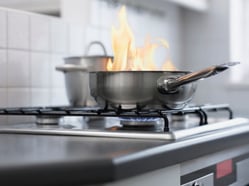We spend so much time cooking meals on our stoves that it can be easy to forget the temperatures are high enough to quickly start a fire. Cooking fires can be dangerous and can also cause serious property damage. Cooking causes an average of 172,900 fires a year and results in an average of 550 deaths a year, according to the National Fire Protection Association (NFPA) home cooking fires report. The NFPA report also found that cooking fires were twice as likely to happen in apartments versus one- and two-family homes. For owners and managers of apartment buildings, this is a concerning fact.
Preventing Cooking Fires in Apartment Buildings
There are a couple of steps building owners and managers can take to keep their tenants and buildings safe. Every building should follow the law regarding smoke detectors, both in common areas and every unit. Regular testing and battery replacement is also very important. Equipping each unit with a fire extinguisher can also help minimize property damage if a fire does start. It’s also important for stoves to be regularly cleaned and properly maintained. If appliances are getting old and worn down, owners should invest in replacements.
There are also automatic fire extinguishing products on the market that building owners can purchase and install in each unit. These extinguishing products are small and easily installed above the stove. If a fire starts and the flames reach the range hood, a fire suppressing powder is released to cover both front and back burners. These products can prevent extensive property damage from a fire and save lives. West Bend customers can also get a discount on StoveTop FireStop extinguishing products! Read through this flyer for more information on StoveTop and West Bend’s discount.





